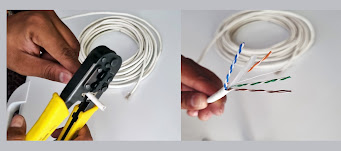What is Cat6 Cable and How to make a Cat6 ethernet cable | Cctv Friend
Cat6 or UTP or Ethernet Cable:
Cat6 or Category 6 cable is a part of the network UTP Cables and is one of the most used UTP cables in the network and surveillance industry worldwide.
Making yourself a Cat6 cable is a good skill in networking and the video surveillance industry and is very easy to learn. The following picture depicts how the Cat6 cable looks inside and outside and how many pairs of cables inside are available.
Other Details about cat6 cable:
- Mainly used for computer networks and installation for IP or Network cameras.
- Cat6 has 8 insulated copper wires.
- All 8 wires were twisted in four pairs.
- It can reach 1000 megabits or 1 Gbps of data transfer speed or maybe more.
- The maximum allowed limit for Cat5e or Cat6 cable is 100 meters.
Globally following two-color code or technical standard for making a cat6 cable.
1: ANSI/TIA-568-A or T568A
Second most used color standard in the world. The Color pair of this T568A is the following.
- White Green
- Green
- Orange White
- Blue
- Blue White
- Orange
- Brown White
- Brown
2:ANSI/TIA-568-B or T568B
Most used color standard in the world. The Color pair of this T568A is the following.
- Orange White
- Orange
- Green White
- Blue
- Blue White
- Green
- Brown White
- Brown
Tools/Equipment needed for Making an Ethernet cable or Cat6 cable.
1: Rj-45 Crimp Tool
2: 8P8C Modular plug or Rj45 connector
3: Cat6 Cable
4: Cat6 Cable Tester
 |
| Crimping tool |
 |
| 8P8C aka RJ45 Connector |
Steps for making a Cat6 cable:
Step 1: With the Crimp tool's help, remove the cable cover like in the following picture.
Step 2: Untwist all cables separately and make sure all the separated cables are straight. All straight 8 cables are arranged with the color code like in the following picture.
Step 4: Repeat all the above steps for the other-hand side of the cable and with the help of a Cat6 tester you can check the connection status of the cable.






Post a Comment